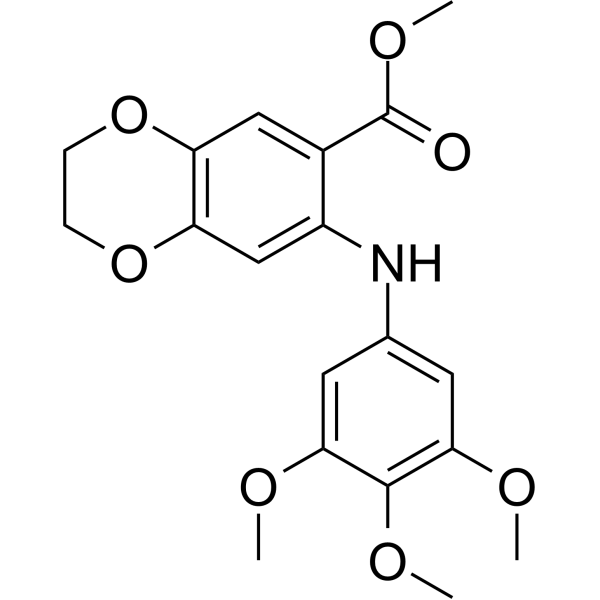产品
编 号:F755878
分子式:C19H21NO7
分子量:375.37
分子式:C19H21NO7
分子量:375.37
产品类型
规格
价格
是否有货
结构图

CAS No: 2768613-52-9
产品详情
生物活性:
Tubulin polymerization-IN-6 (compound 5f) is a potent tubulin polymerization inhibitor, with an IC50 of 1.09 μM. Tubulin polymerization-IN-6 inhibits cell migration and tube formation and contributes to the anti-angiogenesis. Tubulin polymerization-IN-6 can greatly inhibit tumor growth on HT29 xenograft Balb/c nude mice.
体内研究:
Tubulin polymerization-IN-6 (compound 5f) (HT29 xenograft Balb/c nude mice, 0-10 mg/kg, IP, once every two days, for three weeks) dose-dependently inhibits the tumor growth.Tubulin polymerization-IN-6 (SD rats, 10 mg/kg, IV, once) shows the better pharmacokinetic properties.Pharmacokinetic Parameters of Tubulin polymerization-IN-6 in SD rats.Parameters5f
t1/2 (h)1.73
AUC (μg/L·h)5.67
MRT (h)1.92
CL (L/h/kg)1.76
Tmax (h)0.14
Cmax (ng/mL)6.88
Animal Model:Immunodeficient Balb/c nude mice (HT29 xenograft, 5-week-old, 36 mice, six groups)
Dosage:0, 5, 7.5, 10 mg/kg
Administration:IP, once every two days, for three weeks
Result:Dose-dependently inhibited the tumor growth, inhibits the tumor weight growth by 75.5% at 10 mg/kg.
Animal Model:SD rats (5-week-old)
Dosage:10 mg/kg
Administration:IV, once (Pharmacokinetic Analysis)
Result:Showed the better pharmacokinetic properties, exhibited an eight-fold half-life and a two-fold AUC improvement.
体外研究:
Tubulin polymerization-IN-6 (compound 5f) (0-20 μM, 24 h) shows a broad spectrum of anti-proliferation activity against cancer cell lines.Tubulin polymerization-IN-6 (0-100 nM, 24 h) inhibits tumor cells colony formation, up-regulates the expression of Ac-α-tubulinand DeY-α-tubulin .Tubulin polymerization-IN-6 (0-5 μM, 1 h) competes with colchicine and directly binds to the colchicine binding site, thus inhibit tubulin polymerization.Tubulin polymerization-IN-6 (0-250 nM, 24 h) possesses a favorable anti-migration activity against cancer cells.Tubulin polymerization-IN-6 (0-50 nM, 24 h) has the ability to inhibit the angiogenesis of HUVEC cells.Tubulin polymerization-IN-6 (0-100 nM, 24 h) induces cell cycle arrest by regulating associated proteins, induces apoptosis by regulating associated proteins and down-regulating mitochondrial membrane potential, and dose-dependently promotes the production of ROS in HT29 cells.
Tubulin polymerization-IN-6 (compound 5f) is a potent tubulin polymerization inhibitor, with an IC50 of 1.09 μM. Tubulin polymerization-IN-6 inhibits cell migration and tube formation and contributes to the anti-angiogenesis. Tubulin polymerization-IN-6 can greatly inhibit tumor growth on HT29 xenograft Balb/c nude mice.
体内研究:
Tubulin polymerization-IN-6 (compound 5f) (HT29 xenograft Balb/c nude mice, 0-10 mg/kg, IP, once every two days, for three weeks) dose-dependently inhibits the tumor growth.Tubulin polymerization-IN-6 (SD rats, 10 mg/kg, IV, once) shows the better pharmacokinetic properties.Pharmacokinetic Parameters of Tubulin polymerization-IN-6 in SD rats.Parameters5f
t1/2 (h)1.73
AUC (μg/L·h)5.67
MRT (h)1.92
CL (L/h/kg)1.76
Tmax (h)0.14
Cmax (ng/mL)6.88
Animal Model:Immunodeficient Balb/c nude mice (HT29 xenograft, 5-week-old, 36 mice, six groups)
Dosage:0, 5, 7.5, 10 mg/kg
Administration:IP, once every two days, for three weeks
Result:Dose-dependently inhibited the tumor growth, inhibits the tumor weight growth by 75.5% at 10 mg/kg.
Animal Model:SD rats (5-week-old)
Dosage:10 mg/kg
Administration:IV, once (Pharmacokinetic Analysis)
Result:Showed the better pharmacokinetic properties, exhibited an eight-fold half-life and a two-fold AUC improvement.
体外研究:
Tubulin polymerization-IN-6 (compound 5f) (0-20 μM, 24 h) shows a broad spectrum of anti-proliferation activity against cancer cell lines.Tubulin polymerization-IN-6 (0-100 nM, 24 h) inhibits tumor cells colony formation, up-regulates the expression of Ac-α-tubulinand DeY-α-tubulin .Tubulin polymerization-IN-6 (0-5 μM, 1 h) competes with colchicine and directly binds to the colchicine binding site, thus inhibit tubulin polymerization.Tubulin polymerization-IN-6 (0-250 nM, 24 h) possesses a favorable anti-migration activity against cancer cells.Tubulin polymerization-IN-6 (0-50 nM, 24 h) has the ability to inhibit the angiogenesis of HUVEC cells.Tubulin polymerization-IN-6 (0-100 nM, 24 h) induces cell cycle arrest by regulating associated proteins, induces apoptosis by regulating associated proteins and down-regulating mitochondrial membrane potential, and dose-dependently promotes the production of ROS in HT29 cells.
产品资料

